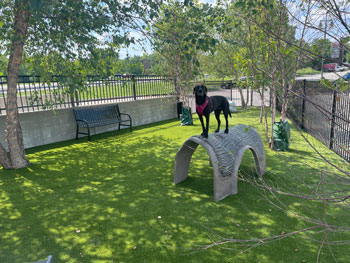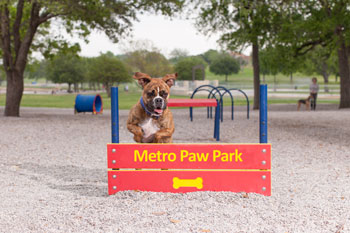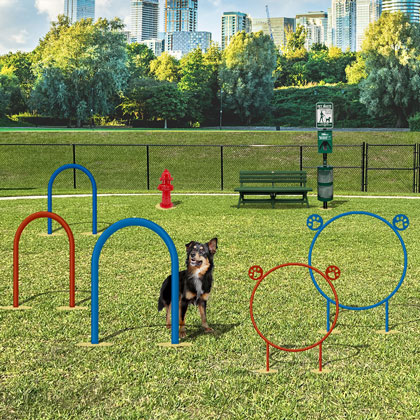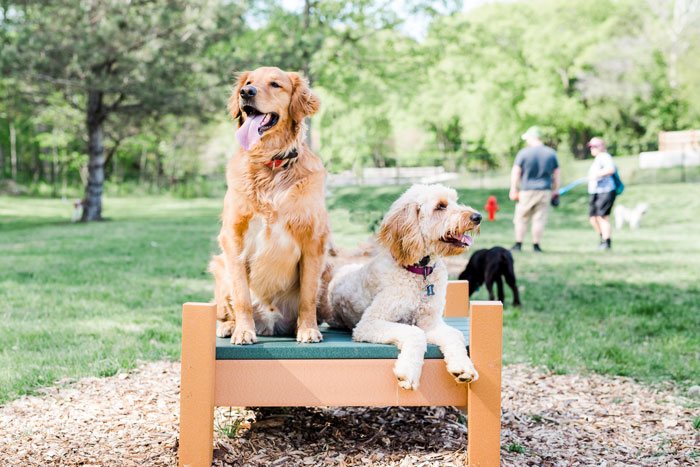Dog parks are popular options for parks planning new amenities, and there are several reasons why, according to dog park experts and designers. Certainly, the pandemic fueled demand in the past few years, but a surge in the number of off-leash dog parks in the U.S. existed even earlier.
In their latest survey on dog parks, the Trust for Public Land indicated that from 2009 to 2020, the number of dedicated off-leash dog parks in the U.S. increased by over 42% to more than 800.
“This increase is due to several factors and is a reflection of a population shifting closer to more urbanized areas, where there is a lack of open spaces for dog owners to exercise their pets safely,” said John Sarver, director of design for an Indianapolis-based company specializing in dog park design and operations as well as manufacturing dog-related products. “In the past, dog parks were situated in more remote areas,” Sarver continued, “but we are now seeing a transition to putting the park closer to other, more mainstream and denser populations, and making it more of a focal point in the community.
“For many dog owners,” Sarver continued, “having access to dog parks is crucial to providing quality care for their pets. Off-leash dog parks in particular are becoming the most popular type of park in America’s largest cities. This is because they provide dog owners with a safe and fenced space where their dogs can run free and socialize with other animals. In addition, the parks often contain dog-specific amenities such as drinking fountains, waste disposal areas, shaded seating areas and agility-training zones.”

“Another reason for the surge in the number of dog parks is that pet ownership in general has seen a steady increase for the past 30 years or so,” said Nora VandenBerghe, managing partner of a Seattle-based dog park design and equipment manufacturer, “especially now with millennials and Gen X. A lot of younger folks are either deciding to not have children or pushing it out to later in life, and during that time have become pet owners.”
Meanwhile, people are treating their “furry friends” like family, she said, “So, as open spaces decrease, even in rural areas of farmland, there is a trend where people from those areas are moving into smaller communities, or eventually to suburban or urban areas, where open space is needed for their pets.
“What we’ve seen in the past decade,” VandenBerghe continued, “is where many of these new developments, whether apartment communities or condominiums—the vast majority of them that are being designed and built now are including dog parks. Dog parks in those types of communities used to be an afterthought. But there is an understanding that residents who have pets require some kind of green space for those pets. So, we are seeing site plans from architects who are including dog parks in their plans. That’s been an interesting shift.”
Gone are the days when only homeowners could have dogs. Many multi-family communities are lifting restrictions, allowing more and more people to bring canine companions into their homes. Flexible work schedules have also increased people’s capabilities for pet ownership. “People want their dogs to have a space to run, play and socialize, and dog parks are the perfect solution to meet these needs. It’s all about giving our canine companions the best life possible,” said Mimi Marler, marketing director of a Chattanooga, Tenn.-based manufacturer of commercial grade outdoor recreation products.
Dog parks offer recreational opportunities for the entire community—human and canine. They are typically inclusive and accessible, and they are not age-specific. “Indeed, dog parks are intergenerational too, and so are aligned to the trend in families staying and playing together that has only grown since COVID,” said Anne-Marie Spencer, corporate vice president, marketing, of a Chattanooga, Tenn.-based park design and structure manufacturing company.
“Dog parks are one more type of civic infrastructure used to accommodate a need—dogs are provided with the opportunity to exercise, socialize and play off-leash,” Spencer explained. “Equally important, dog owners have a place to socialize with other dog owners and provide a space where people from diverse neighborhoods and backgrounds can meet and form friendships.”
Pandemic Effects
The pandemic in 2020 changed everything, including pet ownership. “The effect of the pandemic absolutely fueled the
growth of dog parks” said VandenBerghe. “Pets are a lifeline for people. They provide unconditional love, even from a mental health perspective, having a pet and caring for it in return was really valuable for people during the pandemic.”
Urban areas were hit hard by the pandemic, and many forms of recreation were shut down. Within parks, playgrounds were closed. But there were some open-space dog parks that were still able to stay open. People could keep socially distant and there weren’t as many touch points.
“So, for people being able to be outside and recreate very safely with that social distance while still providing exercise for their dogs was meaningful. It was also a way of maintaining a connection with other members of their community. We kept hearing how valuable that was,” VandenBerghe explained.
During the pandemic, many municipalities that still had community development funds available were able to shift some of those funds to building or improving a dog park.
“The pandemic absolutely played a role in this surge,” Marler said. “With more people stuck at home, many turned to pet ownership for companionship. This not only increased the number of dogs in households but also emphasized the crucial bond between humans and their pets. In some cases, these furry friends became a lifeline for social interaction when other forms of connection were limited.”
During the pandemic there was a huge increase in pet adoptions, VandenBerghe noted. “People shifted from working in offices to working remotely. Even now, there are people working hybrid schedules so those pets who were adopted during the pandemic are still in those homes, apartments.”
A 2023 survey by the ASPCA revealed that since the start of COVID, nearly one in five households acquired a dog, or a cat, accounting for approximately 23 million American households, based on the 2019 U.S. Census. Results of the survey also showed that a majority of those households, post-pandemic, kept their pets or gave them to family or friends. “For these and other reasons, I think the pandemic did influence the pet industry and the increase in both the number of dog parks and the amenities that were put in dog parks,” VandenBerghe said.
A Playground for Dogs

No matter where the park is located, there are some basics that should be included in a design plan, said Sarver. “Having a safe path of egress from the parking lot to the dog park entrance is important. We recommend having a potty area or areas for the dogs to go to the bathroom before entering the park. This helps keep the play area cleaner for the dogs.”
The design of the entrance to the dog park is very important. Sarver recommends that the entrance has an adequate leash-up (double-gated) area for the dogs to prepare to enter or leave the park safely. It is also important to use quality materials on gates and latches so the gates are self-closing and the latches are solid components.
The dog park should be able to accommodate dogs of all sizes and breeds. It is best to have a dedicated small dog area for dogs less than 35 pounds and a large dog area for dogs that are more than 35 pounds. The ideal amount of space for these two areas would be approximately 6,000 square feet for small dog areas and 14,000 square feet for large dog areas, Sarver said.
The design of dog parks is evolving, Sarver added. Parks have come a long way since the first off-leash park, Ohlone, in Berkeley, Calif., circa 1970. “The difference between the older-type dog parks and the newer ones can be summed up in one word: utilities,” said Sarver. “Dogs don’t seem to mind being outside, whether it rains or snows, but people would prefer to be under a shelter. Lighting at night is an amenity, or a restroom for humans. That’s the evolution in going from a rural dog park to a luxury dog park. Also, there is the type of fencing in luxury parks, which can be a more decorative style versus the rural park, which might have an economy-type fence, like a chain link.”
In hot cities, some type of water feature for dogs, like a splash pool, is a good idea. “We make a pool specifically for dogs, and it is really popular in the south,” Sarver said.
“Each dog park presents its own unique set of circumstances regarding what surfaces are best,” he added. “From our observation, dogs prefer playing on natural grass the most. If your dog park can support natural grass, that would always be the preferred surface. But from an aesthetics standpoint and a maintenance standpoint, sometimes artificial turf can make sense, especially in a facility that has a high volume of dogs. So that can be considered upscale as well. That way you are assured your surface is always green, no matter how many dogs pee on it.”
The entrance is usually the highest-traffic area, Sarver continued, “so make sure you put a durable surface near the entrance, but as you transition into the play area, natural grass is the best surface if your park can support the grass. Having an irrigation sprinkler system can help keep the grass healthy during dry spells.”
A Little Luxury
Dog parks can range from basic relief areas to extravagant canine playgrounds. “High-end or luxury dog parks take things up a notch,” Marler said. “They offer custom features, top-notch pup-friendly turf, spacious layouts with agility equipment, innovative play structures, shade, shelter, seating and some even offer water features. These parks make you feel like you’re in a doggie wonderland, providing both dogs and their owners with a special and upscale experience.”
These luxury high-end dog parks are a trend, said VandenBerghe. “For so long, dog parks were just open spaces fenced off, without typical amenities you’d see in other parks, like restrooms and shade shelters. It was very basic. I think there has been a natural evolution in what people expect out of parks, and that also includes dog parks.”
When you are looking at high-end parks, VandenBerghe said, “there will be components for dogs to engage with ramps, other structures they can run on. Tunnels to run through. Jumps to and from different heights. There needs to be a place to accommodate different skill sets and dogs of all sizes and abilities.
“Dogs have different play styles,” VandenBerghe added. “I always recommend small and large dog size areas to help keep the peace and make sure some of the smaller dogs are able to play safely without getting underneath a larger dog.”
Luxury dog parks often include a pet wash area where people can do a bit of cleanup after the park, dog drinking fountains, shade shelters and a seating area. “It’s all about creature comforts,” VandenBerghe said. “Dogs don’t pay taxes; we do. So dog parks should have the amenities for people as well: seating, shade shelters for inclement weather. Making sure people are comfortable if it is 100 degrees outside or if it is 50-something and raining.”
Some Keys to Success

When it comes to making a dog park successful, incorporating a variety of dog agility elements is key, Marler suggested.
These obstacles not only provide physical exercise but also mental stimulation and strengthen the bond between dogs and their owners. Here are some examples of essential agility equipment:
- A-Frames: A-frames are great for building a dog’s confidence. They encourage them to climb up and down, which is both physically challenging and mentally engaging. It’s a bit like a canine confidence booster.
- Hoop Jumps: Hoop jumps are a fun way to get dogs to leap through a hoop. It improves their coordination and agility, and it’s an activity dogs and owners can enjoy together.
- Dog Walks: Dog walks consist of narrow platforms raised off the ground. They help dogs with balance and focus, which can translate to better obedience and control in everyday situations.
- Tunnels: Tunnels are a favorite among dogs. They teach them to be bold and explore, as dogs love to dash through them, promoting courage and trust in their owners.
- Weave Poles: Weave poles challenge a dog’s agility and flexibility. They learn to navigate through a series of poles, which sharpens their coordination and keeps them engaged.
- Pause Tables: Pause tables are great for teaching control. They encourage dogs to pause and wait, which is a very important skill to have.
By including these agility obstacles, Marler said, “you will create a dynamic and enriching environment in the dog park. Dogs get physical exercise and mental stimulation, while owners bond with their pets through training and play. It’s a win-win situation for both dogs and their human companions.”
“Products should be designed to give the dog exercise, but they are also designed to be safe,” Sarver added. “They are individual items so you can spread them out in the park. We don’t like all the dogs to be gathered in one place. I like to see the dogs spread out. Having individual products for the dogs to play on is ideal. Placing these products throughout the whole park can help spread out the users and the dogs. You want to spread out your benches, shade structures, water fountains, dog play equipment and other amenities throughout the whole park so people and dogs will migrate to the back of the park thus keeping the entrance area clear for people and dogs to enter and leave the park without a crowd bottlenecking near the entrance.”
Thinking Outside the Box
VandenBerghe encourages people to be creative, and sometimes, dog park planners have no other option but to do so. “Not every city or town, community or campground has acres of open space. For instance,” she said, “multi-family developments literally might have to go up and do something on their rooftops. Whereas rooftop terraces were once overlooked, with dog parks becoming somewhat of a norm or a standard to pet owners, rooftops are now seen as a unique community space with the ability to host a wide range of amenities, including dog parks.”
VandenBerghe and her company have come up with several other “outside the box” ideas for dog parks. “We’ve done dog parks inside of a covered garage,” she said, “and that is a great option. It is secure and you’d have 24/7 access to them. That’s good for people with nontraditional work schedules. Especially for a garage situation. It’s covered, so it can be used regardless of what the weather is. There are also tennis and sports courts conversions. Dog parks will typically get much more use than a tennis court might.
“The city of Seattle has a dog park underneath roadway I-5. That space was not ideal for other types of park applications,” Vandenberghe added. “But in this case it was perfect, here this a steep slope with easy access for anybody coming into town on the freeway if somebody needs to relieve their pet. It is covered by the overpass so there is protection from the elements.”
Look around and think, VandenBerghe advises. Do you have a big space? Or a little space, such as in New York City where you see a lot of pocket parks? Even if you can only squeeze in one bench and a fire hydrant, “it can still wind up being a very important gathering space for people in the community.” RM



